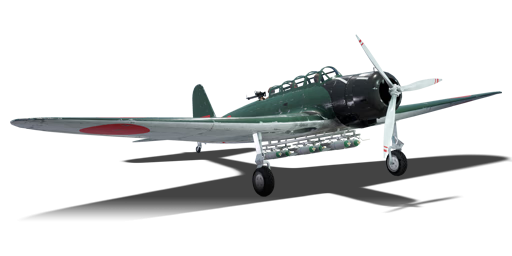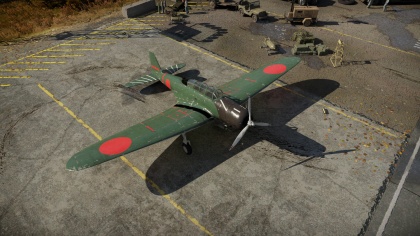Difference between revisions of "B5N2"
(Added tables and basic info.) |
(Updated information.) |
||
| Line 200: | Line 200: | ||
| Radiator | | Radiator | ||
| | | | ||
| + | | 17 3/4 in (mod45) | ||
| | | | ||
|- | |- | ||
| Line 206: | Line 207: | ||
| Compressor | | Compressor | ||
| Airframe | | Airframe | ||
| − | | | + | | Turret 7 mm |
| + | | Improved Torpedo | ||
|- | |- | ||
| III | | III | ||
| Line 213: | Line 215: | ||
| | | | ||
| | | | ||
| + | | 12 in (mod30) | ||
|- | |- | ||
| IV | | IV | ||
| Line 218: | Line 221: | ||
| Engine Injection | | Engine Injection | ||
| Cover | | Cover | ||
| − | | | + | | New 7 mm MGs (Turret) |
| + | | 14 in (mod35) | ||
|- | |- | ||
|} | |} | ||
Revision as of 01:47, 20 December 2018
Contents
Description
The B5N2 is a Rank I Japanese naval bomber
with a battle rating of 1.0 (AB), 1.3 (RB), and 1.7 (SB). This aircraft has been in the game since the start of the Open Beta Test prior to Update 1.29.
When flying the Nakajima B5N2, always try to avoid enemy fighter aircraft as the defensive armament is very weak. Its a very capable naval bomber overall in the right hands as its very maneuverable.
General info
Flight Performance
| Characteristics | |||||||
|---|---|---|---|---|---|---|---|
| Stock | |||||||
| Max Speed (km/h at 3,600 m) |
Max altitude (meters) |
Turn time (seconds) |
Rate of climb (meters/second) |
Take-off run (meters) | |||
| AB | RB | AB | RB | AB | RB | ||
| 361 | 348 | 8260 | 20.3 | 20.6 | 2.6 | 4.0 | 270 |
| Upgraded | |||||||
| Max Speed (km/h at 3,600 m) |
Max altitude (meters) | Turn time (seconds) | Rate of climb (meters/second) |
Take-off run (meters) | |||
| AB | RB | AB | RB | AB | RB | ||
| 400 | 378 | 8260 | 18.6 | 19.4 | 12.1 | 6.5 | 270 |
Details
| Features | ||||
|---|---|---|---|---|
| Combat flap | Take-off flap | Landing flap | Air brakes | Arrestor gear |
| ✓ | ✓ | ✓ | X | X |
| Limits | ||||
|---|---|---|---|---|
| Wing-break speed (km/h) |
Gear limit (km/h) |
Combat flap (km/h) |
Max Static G | |
| + | - | |||
| 555 | 450 | 420 | ~11 | ~4 |
| Optimal velocities | |||
|---|---|---|---|
| Ailerons (km/h) |
Rudder (km/h) |
Elevators (km/h) |
Radiator (km/h) |
| < 320 | < 320 | < 350 | > 210 |
| Compressor (RB/SB) | ||
|---|---|---|
| Setting 1 | ||
| Optimal altitude | 100% Engine power | WEP Engine power |
| 2,500 m | 950 hp | 1,081 hp |
Survivability and armour
- No armour plating
- No armour glazing
- Critical components located at front of aircraft (fuel, pilot, engine, controls)
- More fuel tanks located in wings near fuselage
Armaments
Offensive armament
Main article: Bombs, Torpedoes
The B5N2 can be outfitted with the following ordnance:
- 6 x 60 kg Navy Type 97 Number 6 ground bombs (360 kg total)
- 2 x 250 kg Navy Type Number 25 Model 2 bombs (500 kg total)
- 2 x 250 kg Type 98 bombs (500 kg total)
- 1 x 800 kg Navy Type Number 80 Model 1 bomb (800 kg total)
- 1 x 800 kg Navy Type 99 Number 80 AP bomb (800 kg total)
- 1 x Type 91 Mod.2 torpedo
- 1 x Type 91 Mod.3 torpedo
Defensive armament
The B5N2 is defended by:
- 1 x 7.7 mm Type 92 machine gun, dorsal gun turret (1,000 rpg)
Usage in the battles
The most important advantage in arcade is the ability to reload bombs and belts midair. This translates especially well with the B5N2. I'd advise against the 800 kg bombs, because the H6K can carry twice as many in exactly the same games. Instead, focus on the enemy ships or pillboxes. Make quick diving attacks, and retreat to the safety of your team's fighters to reload. Staying as low as possible can be a viable strategy, as it is difficult to safely conduct a diving attack on an enemy hugging the trees. If limited to 60 kg bombs, focus on enemy AAA.
Using the 250 kg bombs to destroy enemy ships, or the 60 kg bombs to target AAA is the most helpful thing you can do for the team. Try to distract any enemy that comes after you, or lead them into the guns of your allies. Every minute an enemy is focused on you is a minute your allies don't have to deal with it. Use the environment to hide your approach. Hills, mountains, and clouds are all great tools to hide from enemy fighters, or shield your approach on enemy AAA. If necessary, use the tail gunner to strafe light targets. Shoot any approaching fighter. They know you will probably fail, but they also know people can get lucky.
Manual Engine Control
| MEC elements | ||||||
|---|---|---|---|---|---|---|
| Mixer | Pitch | Radiator | Supercharger | Turbocharger | ||
| Oil | Water | Type | ||||
| Controllable | Not controllable | Not controllable | Not controllable | Separate | Not ontrollable | Not controllable |
Modules
| Tier | Flight performance | Survivability | Weaponry | ||
|---|---|---|---|---|---|
| I | Fuselage Repair | Radiator | 17 3/4 in (mod45) | ||
| II | Compressor | Airframe | Turret 7 mm | Improved Torpedo | |
| III | Wings Repair | Engine | 12 in (mod30) | ||
| IV | Engine Injection | Cover | New 7 mm MGs (Turret) | 14 in (mod35) | |
- When upgrading this plane focus on getting the payload especially the torpedo modification. This is due to the high chance Japan has to get naval maps.
Pros and cons
Pros:
- Fast and maneuverable (powered by Nakajima Sakae 11 14 Cylinder Radial, same engine in the A6M)
- Excellent elevator and rudder authority
- Wide variety of bombs and torpedoes + bomb sight for any kind of situation
Cons:
- Poor roll rate
- No offensive armament
- Weak defense armament
- No armour or bulletproof glass to protect the pilot or crew
- Tremendous fuel load means this plane is prone to fuel tank fires especially any hits to the wing roots (where the fuel tanks are located)
History
The Nakajima B5N2 (Allied code name: Kate) was a plane first flown in January 1937 for the Imperial Japanese Navy. About ~1149 Nakajima B5N Torpedo bombers were made for the Japanese Navy. It would see service in World war 2 and was the Japanese Navy's primary torpedo bomber for the early part of World war 2. The Nakajima B5N Torpedo bomber was credited with the sinking of three US Carriers the USS Lexington CV-2, USS Yorktown CV-6 and USS Hornet CV-8.
Media
An excellent addition to the article will be video guides, as well as screenshots from the game and photos.
Read also
Links to the articles on the War Thunder Wiki that you think will be useful for the reader, for example,
- reference to the series of the aircraft;
- links to approximate analogues of other nations and research trees.
Sources
Paste links to sources and external resources, such as:
- topic on the official game forum;
- page on aircraft encyclopedia;
- other literature.
| Japan bombers | |
|---|---|
| Navy | |
| Carrier-based attack bomber | |
| B5N | B5N2 |
| B6N | B6N1 · B6N2 · B6N2a |
| B7A | B7A2 · B7A2 (Homare 23) |
| Carrier-based dive bomber | |
| D3A | D3A1 |
| D4Y | D4Y1 · D4Y2 · D4Y3 Ko |
| Shipboard Observation seaplane | |
| F1M | F1M2 |
| Land-based Attack bomber | |
| G4M | G4M1 |
| G5N | G5N1 |
| G8N | G8N1 |
| Flying boat | |
| H6K | H6K4 |
| H8K | H8K2 · H8K3 |
| Land-based Bomber | |
| P1Y | P1Y1 |
| Army | |
| Light | Ki-32 |
| Ki-48-II otsu | |
| Heavy | Ki-21-Ia · Ki-21-I hei |
| Ki-49-I · Ki-49-IIa · Ki-49-IIb · Ki-49-IIb/L | |
| Ki-67-I Ko · Ki-67-I otsu | |
| Other countries | ▅B-17E |





